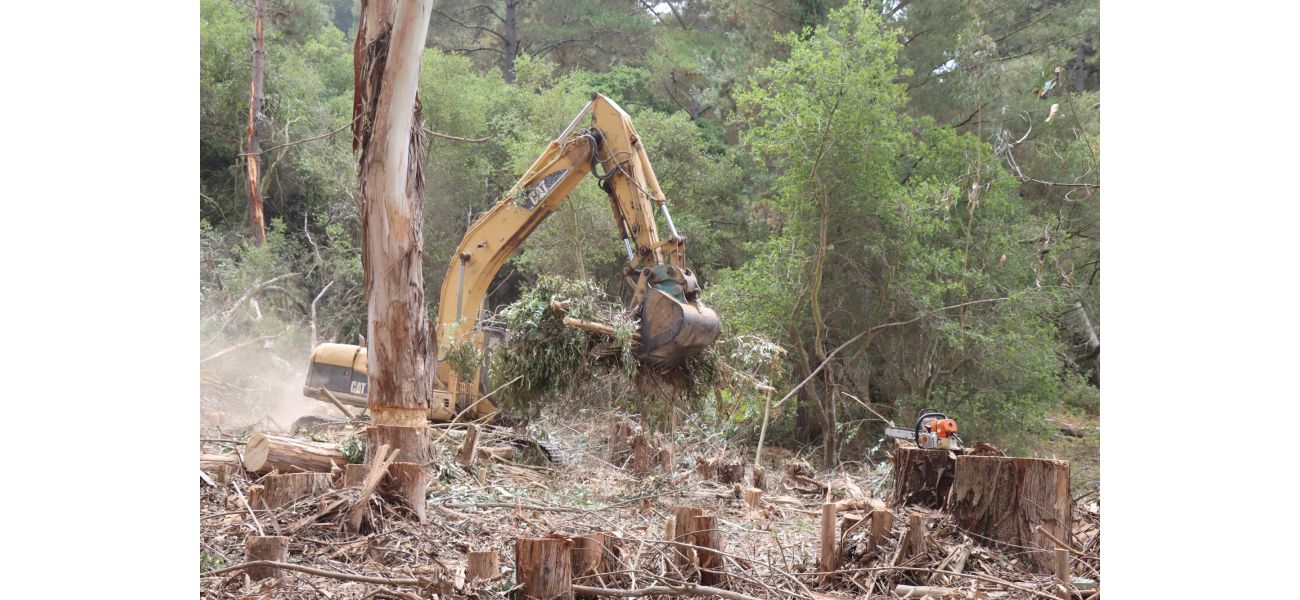Climate change projects in Monterey Bay area include eucalyptus removal and prescribed burns.
New climate change projects started with $71.1 million from federal funds.
October 26th 2024.

In the coastal town of Moss Landing, a series of initiatives to combat the effects of climate change were recently launched. This was made possible by a generous injection of $71.1 million in federal funds. The National Oceanic and Atmospheric Administration (NOAA) awarded this grant as part of the Climate Resilience Regional Challenge, funded by the Inflation Reduction Act. The projects aim to prevent wildfires and floods, promote regional collaboration, and provide workforce development in the Monterey Bay area.
One of the main recipients of this grant is the Esselen Tribe, who will be leading prescribed burns in the area. The Elkhorn Slough Foundation will also be involved in the removal of invasive eucalyptus trees, while other groups will work on reducing vegetation fuels in the Mitteldorf and Santa Lucia Preserves. To engage young people in these projects, Cal State Monterey Bay has received $2 million to fund paid internships, teacher assistant positions, and scholarships.
Gerick Bergsma, assistant professor of marine science at Cal State Monterey Bay, expressed his excitement about the grant, stating that it will allow students to gain valuable hands-on experience in their field of study. He also highlighted how the funding will make these opportunities more accessible to students from diverse financial backgrounds.
These educational opportunities will begin as soon as next spring and will focus on equipping students with the necessary technical skills to contribute to the funded adaptation work. Additionally, other institutions such as Watsonville Wetlands Watch, Hartnell College, and the University of California, Santa Cruz, have also received funds for workforce training.
The recent launch event in Moss Landing was attended by local officials and environmental leaders, who celebrated the award of the highly sought-after federal funds to the California Marine Sanctuary Foundation and its many collaborators. The foundation's executive director, Robert Mazurek, emphasized that this project is not only about protecting the coastline and watersheds but also about safeguarding the heart of our communities and ensuring a future where everyone can thrive despite a changing climate.
This grant is also one of the largest ever awarded to a nonprofit organization in California. The funded projects in Monterey and Santa Cruz Counties focus on low-lying, disadvantaged communities that are at risk of wildfires and flooding from sea level rise and major local rivers. Over $40 million was allocated for flood risk reduction projects, while $11 million was given to five wildfire reduction projects. Another significant portion of the grant, around $9 million, went towards the establishment of a new adaptation revolving fund and the Monterey Bay Climate Adaptation Action Network, which will coordinate implementation and planning.
The network has two liaisons dedicated to collaboration with the eight local tribes and other groups focused on engaging marginalized communities. Nearly $7 million has been allocated for workforce development, which is expected to create 15 full-time jobs, 270 part-time jobs, and over 350 paid internships over the course of five years.
Becky Smyth, the West Coast director of NOAA's coastal management office, praised the funded projects for their inspiring workforce development opportunities. She also commended the collaboration and breadth of the programs, which aim to involve various stakeholders, from those working in wetlands to students pursuing academic careers.
One of the notable projects funded by the grant is the Esselen Tribe's plans to conduct burns on Basin Ranch, a cultural practice that will also help build wildfire resistance and protect culturally significant flora. The Elkhorn Slough Foundation and the Monterey conservation district will work together to remove invasive eucalyptus trees in northern Monterey County, which are a fire hazard. Other projects include fuel load reduction efforts at the Santa Lucia and Mitteldorf Preserves, flood prevention along the Salinas River, and the protection of public access and critical transportation corridors from rising seas in the Elkhorn Slough National Estuarine Research Reserve.
The County of Monterey and the Big Sur Land Trust are also working on redirecting flood waters from the Carmel River to Carmel Lagoon, which has historically caused flooding in nearby residences. These projects are vital for the community's safety and the preservation of the environment.
The grant also includes projects in Santa Cruz County, such as the restoration of wetlands and floodplains in Pajaro, which could mitigate future flooding. Paul Robins, who directs the Monterey conservation district, expressed his gratitude towards the California Marine Sanctuary Foundation for taking on this project and highlighted the broad engagement and collaboration among different groups and communities that have been building over the past 15 years.
One of the main recipients of this grant is the Esselen Tribe, who will be leading prescribed burns in the area. The Elkhorn Slough Foundation will also be involved in the removal of invasive eucalyptus trees, while other groups will work on reducing vegetation fuels in the Mitteldorf and Santa Lucia Preserves. To engage young people in these projects, Cal State Monterey Bay has received $2 million to fund paid internships, teacher assistant positions, and scholarships.
Gerick Bergsma, assistant professor of marine science at Cal State Monterey Bay, expressed his excitement about the grant, stating that it will allow students to gain valuable hands-on experience in their field of study. He also highlighted how the funding will make these opportunities more accessible to students from diverse financial backgrounds.
These educational opportunities will begin as soon as next spring and will focus on equipping students with the necessary technical skills to contribute to the funded adaptation work. Additionally, other institutions such as Watsonville Wetlands Watch, Hartnell College, and the University of California, Santa Cruz, have also received funds for workforce training.
The recent launch event in Moss Landing was attended by local officials and environmental leaders, who celebrated the award of the highly sought-after federal funds to the California Marine Sanctuary Foundation and its many collaborators. The foundation's executive director, Robert Mazurek, emphasized that this project is not only about protecting the coastline and watersheds but also about safeguarding the heart of our communities and ensuring a future where everyone can thrive despite a changing climate.
This grant is also one of the largest ever awarded to a nonprofit organization in California. The funded projects in Monterey and Santa Cruz Counties focus on low-lying, disadvantaged communities that are at risk of wildfires and flooding from sea level rise and major local rivers. Over $40 million was allocated for flood risk reduction projects, while $11 million was given to five wildfire reduction projects. Another significant portion of the grant, around $9 million, went towards the establishment of a new adaptation revolving fund and the Monterey Bay Climate Adaptation Action Network, which will coordinate implementation and planning.
The network has two liaisons dedicated to collaboration with the eight local tribes and other groups focused on engaging marginalized communities. Nearly $7 million has been allocated for workforce development, which is expected to create 15 full-time jobs, 270 part-time jobs, and over 350 paid internships over the course of five years.
Becky Smyth, the West Coast director of NOAA's coastal management office, praised the funded projects for their inspiring workforce development opportunities. She also commended the collaboration and breadth of the programs, which aim to involve various stakeholders, from those working in wetlands to students pursuing academic careers.
One of the notable projects funded by the grant is the Esselen Tribe's plans to conduct burns on Basin Ranch, a cultural practice that will also help build wildfire resistance and protect culturally significant flora. The Elkhorn Slough Foundation and the Monterey conservation district will work together to remove invasive eucalyptus trees in northern Monterey County, which are a fire hazard. Other projects include fuel load reduction efforts at the Santa Lucia and Mitteldorf Preserves, flood prevention along the Salinas River, and the protection of public access and critical transportation corridors from rising seas in the Elkhorn Slough National Estuarine Research Reserve.
The County of Monterey and the Big Sur Land Trust are also working on redirecting flood waters from the Carmel River to Carmel Lagoon, which has historically caused flooding in nearby residences. These projects are vital for the community's safety and the preservation of the environment.
The grant also includes projects in Santa Cruz County, such as the restoration of wetlands and floodplains in Pajaro, which could mitigate future flooding. Paul Robins, who directs the Monterey conservation district, expressed his gratitude towards the California Marine Sanctuary Foundation for taking on this project and highlighted the broad engagement and collaboration among different groups and communities that have been building over the past 15 years.
[This article has been trending online recently and has been generated with AI. Your feed is customized.]
[Generative AI is experimental.]
0
0
Submit Comment





